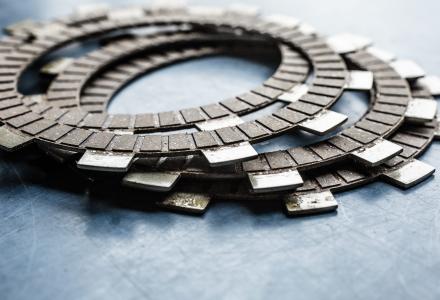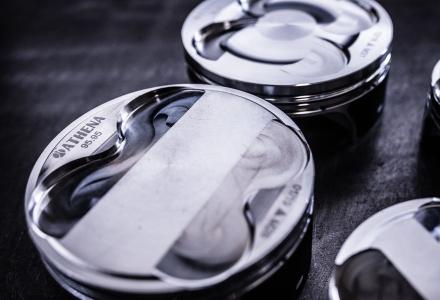Cylinder Kit: What it does, how to install and main types
The cylinder kit, commonly known as CK, is a vital component in the mechanics of motorcycles and scooters. Essentially, it serves as the core of an internal combustion engine and primarily consists of a cylinder, piston, and cylinder head.
Let's delve into its detailed explanation and learn how to install it in the event of repair or replacement. Those participating in competitive sports often opt to replace the original cylinder kit with an aftermarket alternative such as those offered by Athena. These aftermarket kits are designed to enhance performance while maintaining the motorcycle's reliability. Replacing the cylinder kit typically does not require modifications to the motorcycle's engine cases. Remember that each new cylinder kit requires a break-in period: a specific period of time during which the engine should not be operated at high RPM. This allows the mechanical components to properly adjust and settle into place.
What is a cylinder kit and what does it do?
If you are still unsure about the concept of a cylinder kit, it is important to understand that the entire movement of a motorcycle relies on this component. It is where internal combustion occurs, transforming the chemical energy of the fuel into mechanical energy to propel the vehicle forward. In essence, the cylinder kit comprises the cylinder head, cylinder, and piston, complemented by the corresponding piston rings and gaskets.
Here, we outline the specific key elements that constitute a motorcycle's cylinder kit.
- Cylinder: a mechanical element inside of which the piston travels. As the name implies, it has a cylindrical shape and is typically made of aluminum or cast iron. Athena's aluminum cylinders are meticulously engineered in Italy by the company's Research & Development division. They are then coated with motor-nickel-silicon, a nickel silicon plating applied to the cylinder's interior, ensuring excellent smoothness and resistance to wear.
- Piston: A mechanical component that converts the energy released from combustion into rotational force, transmitting it to the engine crankshaft. It may feature one or more piston rings to ensure effective gas seal within the cylinder's combustion chamber.
- Cylinder Head: It seals the upper portion of the cylinder and houses the spark plug(s). In four-stroke engines, it encompasses the intake and exhaust valves, as well as other distribution parts.
Now, let's explore the various types of cylinder kits based on the engine type.

Scooter Cylinder Kits: What are the main ones?
Cylinder kits for scooters come in different types, offering varying levels of reliability and performance.
When purchasing a cylinder kit, the first step is to identify the motorcycle engine type:
- Is it a two-stroke or four-stroke engine? This distinction primarily depends on the number of strokes involved in the combustion process. In a four-stroke engine, these strokes are intake, compression, combustion, and exhaust. In a two-stroke engine, all four phases of the cycle occur within a single rotation of the crankshaft. Two-stroke engines are simpler and more compact, as they lack valves and lubrication systems, making them easier to maintain.
- An engine can be either air-cooled or liquid-cooled. Air-cooled engines are relatively simpler, while liquid-cooled engines have passages surrounding them through which coolant flows, effectively reducing the temperature of the cylinder kit. The coolant is circulated by a pump to the radiator, where it is cooled before returning at a lower temperature.
When purchasing or replacing a cylinder kit for a motorcycle or scooter, it is essential to understand the following two types:
- Standard bore cylinder kit: This type of cylinder kit has the same diameter and displacement as the original.
- Big bore cylinder kit: With a larger diameter than the original, it increases the engine's displacement, significantly improving performance and reliability.
Athena's Big Bore cylinder kits offer remarkable performance enhancements throughout the power curve. This patented technology is utilized in off-road motorcycles and iconic scooters like the Booster or Aprilia SR. By increasing the diameter (Big Bore refers to a larger caliber), both the displacement and available power are increased.
Athena's Standard Bore cylinder kits, developed in-house, provide the same level of performance as the original. They are known for their exceptional reliability and smooth operation. These kits feature a lightweight aluminum cylinder, nickel-silicon-plated barrel, and a piston designed to minimize friction.

Now, let's see how to install a cylinder kit
Although cylinder kits may vary in type and displacement, the process of replacing and installing them is quite similar. You can find detailed instructions for installing each specific cylinder kit on the corresponding pages of the Athena website. Here are the essential steps for installing a cylinder kit on a motocross bike:
- Preliminary Steps
It is good practice to follow these steps, even though they are not directly related to the replacement of the cylinder kit (except for removing the old one, of course). It should be noted that even a small impurity, such as combustion residue, can scratch the cylinder and affect performance.
- Clean the vehicle and the engine. During this phase, the parts should be washed, and the exhaust system, air duct, and fuel supply assembly should be removed.
- Disassemble the cylinder head, cylinder, and piston from the engine.
- Carefully clean the cylinder base surface on the engine casing.
- Clean all the components of the original kit using gasoline and blow compressed air, making sure there are no impurities inside the various channels of the cylinder or in the exhaust valve seat. Protect the openings of the engine casing with a clean cloth.
- Check the wear condition of the components: especially the crankshaft, oil seal, crankshaft bearings, roller cage, and verify the clearance of the connecting rod and exhaust valve. The reliability of the engine is also ensured by the good condition of these components.
- Preparing the piston
Take the piston and install the piston ring(s) and the first wrist pin circlip into their designated seats.
- Assembling the piston
If you removed the studs during disassembly, lubricate them and reinsert them into the engine block (you can use self-locking pliers to hold the stud in place). It's a good practice to cover the cylinder hole in the engine block with a cloth to prevent any objects from falling inside. Lubricate the roller cage and insert it into the connecting rod. Then, align the wrist pin with the inside of the piston and the roller cage, making sure that the arrow marked on the piston crown is facing towards the exhaust side. Secure the wrist pin by placing the second wrist pin circlip on the opposite side of the first one. Applying grease to the wrist pin and piston is recommended for smoother insertion.
- Installing gaskets and tightening the cylinder
Insert the base gasket from the gasket set, then place the piston inside the cylinder and slide the cylinder downwards until it makes contact with the engine block.
- Cylinder head tightening
Begin by inserting the various sealing gaskets (O-rings) into their respective seats, then align the cylinder head with the studs and secure it in place. If you have a detachable cylinder head, you should first assemble the inner dome and then attach the outer part. Use a torque wrench to tighten the four bolts. The specific torque values for your engine can be found in the assembly instructions provided with each Athena cylinder kit.
- Exhaust valve
Depending on the type of cylinder kit you are installing, it may be necessary to install and adjust the exhaust valve. In such cases, it is advisable to follow the instructions provided in the assembly manual.
- Break-in, Usage, and Maintenance
During the initial hours of use, it is important to avoid putting excessive strain on the engine to prevent any damage to the cylinder kit. Optimal performance will be achieved after a proper break-in period. The break-in instructions for your engine can be found in the assembly instructions accompanying each Athena cylinder kit.
Adjusting Squish Clearance
To optimize performance, especially when preparing the motorcycle for competition, you can adjust the squish clearance. This refers to the distance between the piston crown at top dead center and the edge of the combustion chamber.
To measure the squish clearance, follow these steps: manually position the piston towards the bottom dead center, insert a 1.5 mm thick solder wire through the spark plug hole in line with the wrist pin, and manually rotate the engine using the kick-start lever (at least 2-3 times). After this procedure, the solder wire will have a flattened section, which can be measured with a vernier caliper to determine the squish clearance value.
To modify the squish clearance, you can either adjust the piston head (although it is strongly discouraged) or simply replace the base gasket. The optimal squish clearance value depends on the type of cylinder kit you are installing.
Refer to the instructions for the correct value.
Reducing the squish clearance can enhance performance, but be cautious not to decrease the combustion chamber volume too much as it can cause irreversible damage to the entire motorcycle cylinder kit.
Cylinder Kits: Athena's Selection
Choosing the appropriate cylinder kit for your motorcycle is crucial to ensure proper engine function and, consequently, vehicle safety.
Athena offers a wide range of high-quality, durable, and long-lasting cylinder kits for motorcycles. They are designed for easy assembly and come complete with everything you need, from the piston to the set of gaskets and individual O-rings. The following are some of the products available in our online store:
- Big Bore Cylinder Kit with Ø 65 mm Head, 170 cc Central Dome, and Exhaust Valve;
- Standard Bore Cylinder Kit with Ø 90 mm, 400 cc;
- Standard Bore Cylinder Kit with Ø 78 mm, 250 cc;
- Standard Bore Cylinder Kit with Ø 54 mm Head, 125 cc;
- Standard Bore Cylinder Kit with Ø 56 mm Head, 125 cc and Disassemblable Central Dome;
- Big Bore Cylinder Kit with Ø 47.6 mm Head, 70 cc, Compression Ratio 14.1:1.
Visit the Athena website and search for the motorcycle cylinder kits you need. You will find a wide selection of reliable and high-performance products, equal to or better than the original ones.




